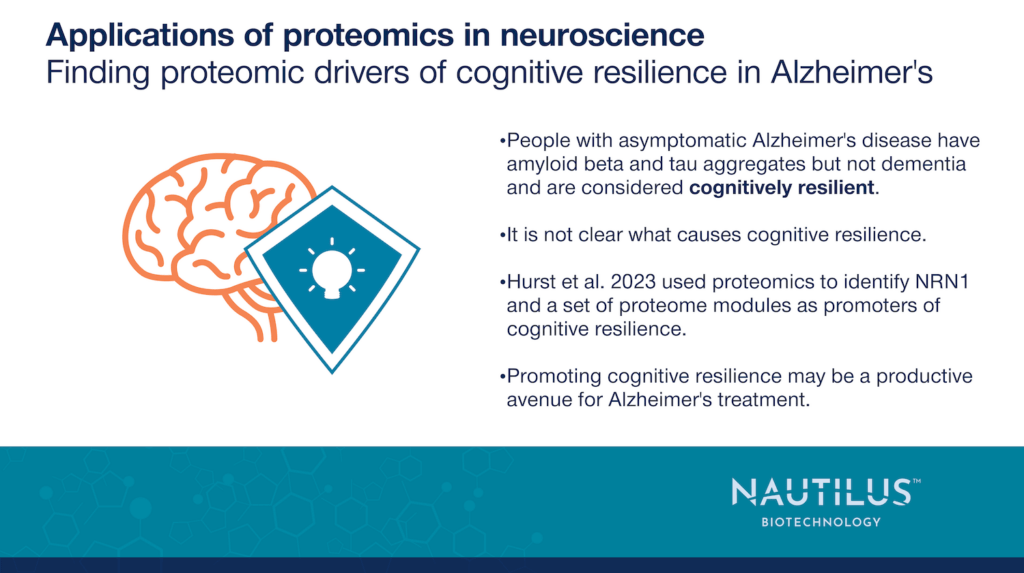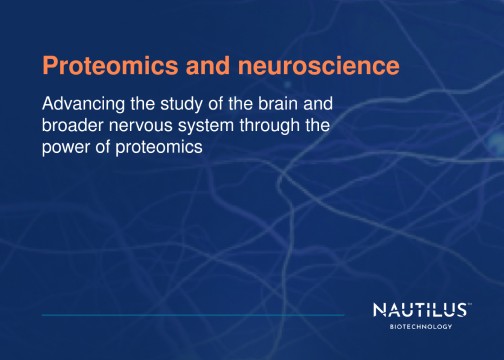
Finding proteomic drivers of cognitive resilience in Alzheimer’s – Applications of proteomics in neuroscience

Tyler Ford
August 1, 2024

Cognitive defects in Alzheimer’s disease follow the accumulation of extracellular amyloid beta plaques and intracellular tau tangles. Nonetheless, there are many unsolved mysteries in Alzheimer’s development and progression. One huge mystery is why some people accumulate plaques and tangles but don’t develop cognitive symptoms. Understanding how these asymptomatic individuals achieve such “cognitive resilience” could enable the development of therapies promoting resilience or biomarkers determining what treatments should be pursued.
Hurst et al., 2023 set out to solve the mystery of cognitive resilience by applying proteomic analysis to brain samples from healthy individuals, those with asymptomatic Alzheimer’s, and those with cognitive defects due to Alzheimer’s. These samples come from the Religious Orders Study/Memory and Aging Project (ROSMAP) wherein Catholic nuns, priests, and brothers 65 and older as well as older persons from retirement communities and senior subsidized housing facilities in the Chicago area volunteer to get medical and physiological (including cognitive) evaluations each year and donate their brains after death. All participants enter the project without known dementia but may develop it over the course of the project.
Using this powerful resource, Hurst et al., 2023 discovered protein modules associated with resilience. They also integrated their findings with previous Alzheimer’s proteomics studies to zero in on the NRN1 protein as a driver of cognitive resilience in Alzheimer’s. Later, they demonstrated NRN1 can protect rat neurons from some of the detrimental effects of amyloid beta and began to elucidate the mechanism through which NRN1 achieves its effects. Their results strongly suggest targeting NRN1 could help prevent or slow the cognitive impacts of Alzheimer’s disease.
Watch this animation to learn how proteomics can fuel neuroscience research.
Identifying proteome modules associated with cognitive resilience and zeroing in on the NRN1 protein
Leveraging the ROSMAP samples, Hurst et al., 2023 measured over 7,700 proteins from brain regions BA6 and BA37 across healthy individuals, individuals with asymptomatic Alzheimer’s, and individuals with Alzheimer’s and cognitive impairment. In both brain regions, they discovered hundreds of proteins with altered abundance in asymptomatic individuals and thousands of proteins with altered abundance in cognitively impaired individuals. As expected, amyloid beta and tau increase in cognitively impaired compared to healthy individuals. To better conceptualize the role of other altered proteins, Hurst et al., 2023 grouped them into modules of co-expressed proteins and functionally annotated them using the cWGCNA algorithm and GO annotation, respectively.
In both brain regions, five modules were increased in asymptomatic Alzheimer’s compared to Alzheimer’s with cognitive impairment while also having a positive correlation with cognition. These included:
- M22 – Synapse
- M5 – Synapse
- M25 – Ribosomal
- M30 – Mitochondria/ER
- M36 – Exocytosis
Modules elevated in Alzheimer’s with cognitive impairment compared to asymptomatic Alzheimer’s and negatively correlated with cognition included:
- M15 – MAPK signaling
- M16 – Gluconeogenesis
To narrow in on some particularly important proteins for cognitive resilience, Hurst et al., 2023 compared their results to those from a previous proteome-wide association study testing protein associations with cognitive resilience in ROSMAP samples (only 30 of which overlapped with Hurst et al., 2023).
Four of the modules from Hurst et al., 2023 were enriched for proteins identified as positively associating with cognitive resilience in the previous study. These included:
- M22 – Synapse
- M5 – Synapse
- M36 – Exocytosis
- M30 – Mitochondria/ER
Being that M22 and M5 were largely associated with synapses and neuronal markers, they narrowed in on these modules and discovered that NRN1 was the most significantly elevated protein in asymptomatic Alzheimer’s vs. Alzheimer’s with cognitive impairment and was also highly associated with measures of cognition in both studies.
NRN1 promotes the formation of neuronal protrusions that can enhance signaling between neurons and can improve learning in animal models. These roles line up well with its potential for improving cognitive resilience.
NRN1 protects neurons from amyloid beta in in vitro models
Amyloid beta decreases the abundance of critical neuronal structures called dendritic spines while also altering their morphology. Dendritic spines are protrusions from neurons that receive signals from other neurons. Impaired dendritic spine biology disrupts neuronal networks and decreasing dendritic spine abundance decreases the total surface area of the cell, making the neurons more compact. This can cause neurons to fire action potentials more readily – i.e. makes them more excitable.
By culturing rat hippocampal neurons in vitro and exposing them to recombinant amyloid beta and NRN1, Hurst et al., 2023 showed that, while amyloid beta alone does decrease dendritic spine abundance and alter dendritic spine morphology, NRN1 prevents these effects. Furthermore, either amyloid beta or NRN1 alone increase neuronal excitability, but combining them restores excitability to normal levels. It is unclear why NRN1 alone increases excitability, but its impacts on the effects of amyloid beta are promising signs of its powerful role in cognitive resilience.
How does NRN1 cause cognitive resilience?
Diving into the potential mechanisms underlying cognitive resilience, Hurst et al., 2023 first showed that NRN1 does not prevent amyloid beta aggregation. Then, they treated rat primary neurons with recombinant NRN1 protein and measured changes in the proteome. They discovered 216 proteins with significantly altered abundance at a false discovery rate of 10% and found that 7 human brain modules are enriched with these proteins. Four human modules were enriched with proteins that increased in response to NRN1:
- M22 – Synapse
- M5 – Synapse
- M4 – Synaptic vesicle
- M19 – ATPase activity
Three modules were enriched with proteins that decreased in response to NRN1 treatment:
- M8 – RNA splicing
- M31 – Translation initiation
- M12 – Hydrolase activity
The consistent association of M22 and M5 with cognitive resilience highlights these modules as particularly important for resilience and warrants further study.
A role for cognitive resilience in Alzheimer’s treatments
Approved Alzheimer’s treatments and clinical trials largely focus on amyloid beta and tau. This is reasonable considering the strong correlation between these proteins, their aggregation, and the progression of Alzheimer’s disease. Nevertheless, Hurst et al., 2023 make it clear that cognitive resilience plays an important role in the Alzheimer’s story. Their cross-disciplinary work leverages human samples, proteomics, in vitromodels, and a keen understanding of neuronal biology to identify many potential points of intervention that could enhance cognitive resilience. They show that NRN1 is particularly important, but many proteins in the altered modules may play important roles as well.
It will be interesting to follow how the networks of interactions between these proteins are studied and hopefully manipulated to improve Alzheimer’s treatment. This kind of work is only possible with powerful proteomics tools, and we’re excited to see how next-generation tools like the NautilusTM Proteome Analysis Platform accelerate these studies in the near future.
Find more applications of proteomics in our Proteomics and neuroscience eBook.
MORE ARTICLES

